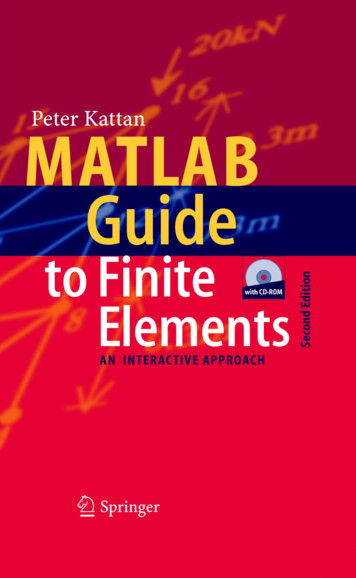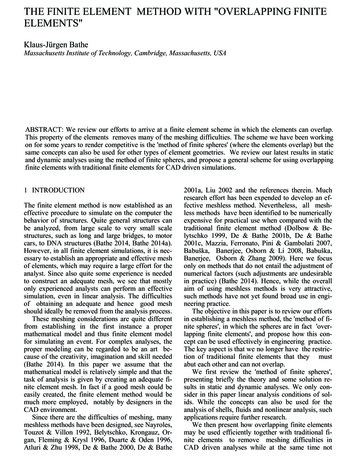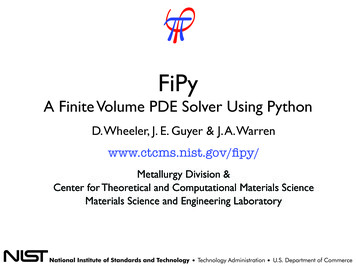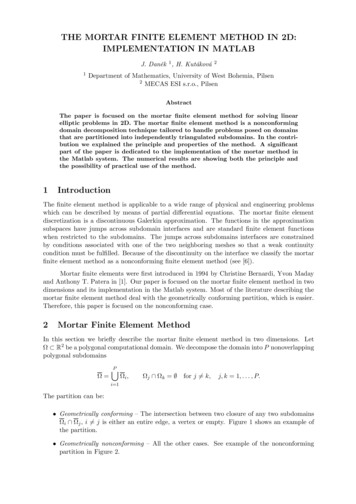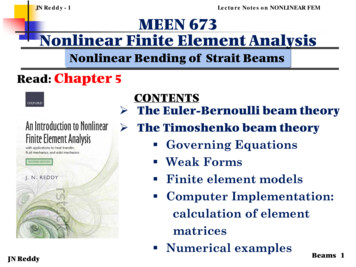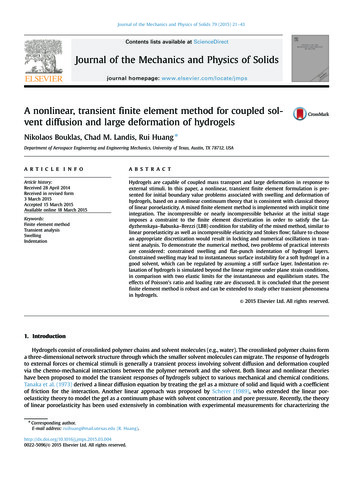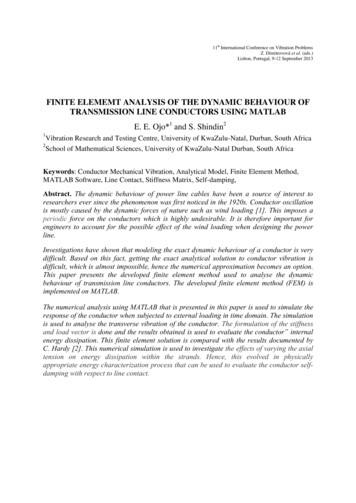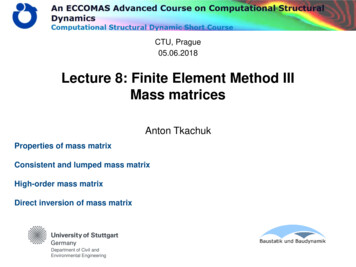
Transcription
CTU, Prague05.06.2018Lecture 8: Finite Element Method IIIMass matricesAnton TkachukProperties of mass matrixConsistent and lumped mass matrixHigh-order mass matrixDirect inversion of mass matrixDepartment of Civil andEnvironmental Engineering
Mass matricesBaustatik und BaudynamikUniversität StuttgartMotivation for mass matrices discrete representation of inertia properties of structures needed for transient analysisLectures 17 and 19 modal and spectral analysesLecture 16 harmonic analysis gravity load and Rayleigh model of dampingLecture 22Mass matrices influence computational cost in explicit transient and modal analysesLectures 17 and 19 accuracy through discretization (dispersion) errorLectures 8 and 16Understanding and choosing mass matrices is important!2
Properties of mass matrixBaustatik und BaudynamikUniversität StuttgartPhysical properties matrix symmetry positive definiteness (semi-positive) preservation of total translational mass physical symmetrywith unit motion in x-,y- or z-directionAlgorithmic properties low fill-in or sparsity (ideally diagonal) easiness of computation3
Consistent mass matrix for continuaBaustatik und BaudynamikUniversität StuttgartVirtual work principleSpatial discretizationDynamic equation of motionConsistent mass matrix (CMM)Internal and external force vectors4
Consistent mass matrix for continuaExample: 2-node truss in 1DShape function in isoparametric coordinatesBaustatik und BaudynamikUniversität StuttgartExample: 3-node triangle in 2DShape function in isoparametric coordinatesConsistent mass matrix on element level(constant density and cross-section)Consistent mass matrix on element level(constant density)5
Consistent mass matrix for continuaExample: 4-node quadrilateral in 2DShape function in isoparametric coordinatesBaustatik und BaudynamikUniversität StuttgartProperties of consistent mass matrix matrix symmetry (by construction) positive definiteness (for full integration) preservation of total translational mass(for full integration)Consistent mass matrix on element levelvia 2x2 numerical quadrature (Gauss) physical symmetry low fill-in but non-diagonal easiness of computationNote: 8-node hexahedron requires3x3x3 quadrature6
Consistent mass matrix for continuaBaustatik und BaudynamikUniversität StuttgartExample: 10-node tetrahedral in 3DTensor products rule are not symmetric andleading to physically unsymmetric matrix.No closed expression of the quadrature areavailable numerical search,e.g. Felippa rulesCARLOS FELIPPA, A COMPENDIUM OF FEM INTEGRATION FORMULAS FOR SYMBOLIC WORK, ENGINEERINGCOMPUTATION, VOLUME 21, NUMBER 8, 2004, PAGES 867-890.AVAILABLE AS FORTRAN AND MATLAB CODE FOR 1-, 4-, 8-, 14-, 15-, 24-POINT R FROMHTTPS://PEOPLE.SC.FSU.EDU/ JBURKARDT/M SRC/TETRAHEDRON FELIPPA RULE/TETRAHEDRON FELIPPA RULE.HTML7
Lumped mass matrixBaustatik und BaudynamikUniversität StuttgartMotivation for lumped (diagonalized) mass matrices trivial computation of acceleration from the force vector increased critical time step with respect to consistent mass matrixLecture 17 reduced storage in RAM reduced cost in modal analysisMethods for mass lumping (diagonalization) row-sum-lumping Hinton-Rock-Zienkiewicz method (1976) nodal quadrature for elements with Gauss-Lobatto nodal location8
Lumped mass matrixRow-sum-lumping1. Starting point: consistent mass matrix2. Add all terms at each row to diagonalBaustatik und BaudynamikUniversität StuttgartExample: 3-node triangle in 2DConsistent mass matrix on element level(constant density)Example: 2-node truss in 1DConsistent mass matrix on element level(constant density and cross-section)Lumped mass matrix by row-sum-diagonalizationLumped mass matrix by row-sum-diagonalization9
Lumped mass matrixExample: 8-node quadrilateral in 2D(Serendipity)Baustatik und BaudynamikUniversität StuttgartLumped mass matrix by row-sum-diagonalization(constant density and Jacobian)Shape function in isoparametric coordinatesnegative terms at corner nodes!The same problem is observed for quadratic10-node tetrahedral finite elementLumped mass matrix by row-sum-diagonalization(constant density and Jacobian)negative terms at corner nodes!Remedy: Hinton-Rock-Zienkiewicz method10
Lumped mass matrixBaustatik und BaudynamikUniversität StuttgartHinton-Rock-Zienkiewicz method1. Starting point: consistent mass matrix2. Compute some of all diagonal terms of CMMfor one spatial direction3. Compute diagonal terms as total massof the elements scaled with ratio of diagonalterm to the sum of diagonal termsExample: 8-node quadrilateral in 2D(Serendipity)Example: quadratic 10-node tetrahedralfinite elementLumped mass matrix by HRZ lumping(constant density and Jacobian)Lumped mass matrix by HRZ lumping(constant density and Jacobian)11
High-order mass matricesBaustatik und BaudynamikUniversität StuttgartMotivation for high-order mass matrices the eigenfrequencies for CMM tend to be higher than analytical values the eigenfrequencies for LMM tend to be lower than analytical values weighted some of both can cancel the error and yield better resultsExample: 2-node truss in 1Dfrequency relative errorConsistent and lumped mass matrices(constant density and cross-section)mode numberLumped mass matrix by row-sum-diagonalization12
High-order mass matricesBaustatik und BaudynamikUniversität StuttgartExample: 2-node truss in 1DShape function in isoparametric coordinatesfrequency relative errormode numberConsistent and lumped mass matrices(constant density and cross-section)Lumped mass matrix by row-sum-diagonalization13
Reciprocal mass matricesBaustatik und BaudynamikUniversität StuttgartMotivation for reciprocal mass matrices trivial computation of acceleration from the force vector increased critical time step with respect to lumped mass matrix memory storage comparable with CMM more accurate than HRZ lumping for elements“directly” constructedinverse masswithout stable row-sum-diagonalizetion14
Reciprocal mass matricesBaustatik und BaudynamikUniversität StuttgartVirtual work principle“recast the term”(linear momentum or impulse)(velocity)(free parameter)TKACHUK, A., BISCHOFF, M. (2015).15
Reciprocal mass matricesBaustatik und BaudynamikUniversität StuttgartParametrized virtual work principleSpatial discretizationDynamic equation of motionSpatial discretizationprojectionreciprocal mass matrixmass withprojection16
Reciprocal mass matricesElimination of velocity andmomentum degrees of freedomby static condensationBaustatik und BaudynamikUniversität Stuttgartbiorthogonality conditionDynamic equation of motionwith scaled reciprocal mass matrixPositive definite:positive definiteSparse fill-in of CMM:is block diagonal for element-wise interpolation ofTKACHUK, A., BISCHOFF, M. (2015).17
Reciprocal mass matrices in explicit dynamicsBaustatik und BaudynamikUniversität Stuttgartvelocity shape functions1D:2D:element-wise interpolationlinear momentum shape functionsbiorthogonality conditionsimplex elements: unique choice for momentum shape functionsdisplacementTKACHUK, A., BISCHOFF, M. (2015).linear momentum18
Reciprocal mass matricesBaustatik und BaudynamikUniversität StuttgartUniform mesh, free-free rodAccurate: ref. error for mode 2 and 3 with LMM are 0.4% and 1.6%Efficient: the max. frequency is 77% of the value for LMM ( 29% speed-up)TKACHUK, A., BISCHOFF, M. (2015).19
Reciprocal mass matricesBaustatik und BaudynamikUniversität StuttgartNAFEMS FV32 benchmark:computation of eigenvaluesnon-zero entries ofreciprocal mass matrixTKACHUK, A., BISCHOFF, M. (2015).Satisfactory results for lower frequencies and modesReduction of the highest frequency by 50%20
Reciprocal mass matricestransient analysis of a cantilever beamBaustatik und BaudynamikUniversität Stuttgart16000 steps for LMM vs.12032 steps for VSRMMbending loadTet44000 steps for LMM vs.3008 steps for VSRMMaxial loadVery good results for bending loadGood results for axial loadReduction of the highest frequency by 25%21
CTU, Prague05.06.2018Lecture 8: Finite Element Method IIIMass matricesAnton .uni-stuttgart.deDepartment of Civil andEnvironmental Engineering
Appendix A: Recommended literatureBaustatik und BaudynamikUniversität StuttgartZienkiewicz, O. C., Taylor, R. L., & Zhu, J. Z. (2010). The Finite Element Method: Its Basis andFundamentals, 6th editions. (concise description of consistent and lumped mass matrices)Belytschko, T., Liu, W. K., & Moran, B. Nonlinear finite elements for continua and structures.John Wiley, 2000. (also mass matrices for structural elements)Cohen, G. C. Higher-order numerical methods for transient wave equations. Springer, 2003.(mass lumping for high-order hexahedral and tetrahedral elements)Felippa, Carlos A. "Construction of customized mass-stiffness pairs using templates." Journal ofAerospace Engineering 19.4 (2006): 241-258. (good introduction to customization of massmatrices)Mass Templates for Bar2 ourses.d/MFEMD.d/MFEMD.Ch22.d/MFEMD.Ch22.pdf23
AVAILABLE AS FORTRAN AND MATLAB CODE FOR 1-, 4-, 8-, 14-, 15-, 24-POINT R FROM HTTPS://PEOPLE.SC.FSU. . Lecture 8: Finite Element Method III Mass matrices Anton Tkachuk CTU, Prague 05.06.2018. Baustatik und Baudynamik Universität Stuttgart 23 Appendix A: Recommended literature
